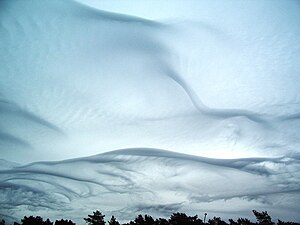Still working to recover. Please don't edit quite yet.
Undulatus asperatus
Undulatus asperatus (or alternately, asperatus) is a cloud formation, proposed in 2009 as a separate cloud classification by the founder of the Cloud Appreciation Society. If successful it will be the first cloud formation added since cirrus intortus in 1951 to the International Cloud Atlas of the World Meteorological Organization.[1] The name translates approximately as roughened or agitated waves.[2]
Margaret LeMone, a cloud expert with the National Center for Atmospheric Research has taken photos of asperatus clouds for 30 years, and considers it a likely new cloud type.[1] On June 20, 2006 Jane Wiggins took a picture of asperatus clouds from the window of a downtown office building in Cedar Rapids, Iowa.[3] In March 2009, Chad Hedstroom took a picture of asperatus clouds from his car near Greenville Ave in Dallas, Texas. Soon after taking it, Wiggins sent her Cedar Rapids image to the Cloud Appreciation Society, which displayed it on its image gallery.[4] Since 2006, many similar cloud formations have been contributed to the gallery,[5] and in 2009 Gavin Pretor-Pinney, founder of The Cloud Appreciation Society, began working with the Royal Meteorological Society to promote the cloud type.[2] Wiggins' photograph was posted on the National Geographic website on June 4, 2009.[3]
The clouds are most closely related to undulatus clouds.[2] Although they appear dark and storm-like, they tend to dissipate without a storm forming.[6] The ominous-looking clouds have been particularly common in the Plains states of the United States, often during the morning or midday hours following convective thunderstorm activity.[7] Template:As of the Royal Meteorological Society is gathering evidence of the type of weather patterns in which undulatus asperatus clouds appear, so as to study how they form and decide whether they are distinct from other undulatus clouds.[2][6]
References
- ↑ 1.0 1.1 "PICTURES: New Cloud Type Discovered?". National Geographic News. 2009-06-03. http://news.nationalgeographic.com/news/2009/06/photogalleries/new-cloud-pictures/.
</li>
- ↑ 2.0 2.1 2.2 2.3 "Asperatus: gathering storm to force new cloud name". London: The Guardian. 2009-06-02. http://www.guardian.co.uk/environment/gallery/2009/jun/01/2?picture=348217732. Retrieved 2010-03-28. </li>
- ↑ 3.0 3.1 MICHAEL J. CRUMB (2009-06-11). "Iowa Woman's Photo Sparks Push for New Cloud Type". The Associated Press. http://www.physorg.com/news163990239.html. </li>
- ↑ http://www.cloudappreciationsociety.org/gallery/index.php?showimage=1692
- ↑ http://www.cloudappreciationsociety.org/gallery/index.php?x=found&quick=Asperatus
- ↑ 6.0 6.1 Luke Salkeld (2009-06-02). "The cloud with no name: Meteorologists campaign to classify unique 'Asperatus' clouds seen across the world". Daily Mail. http://www.dailymail.co.uk/sciencetech/article-1189877/The-cloud-Meteorologists-campaign-classify-unique-Asperatus-clouds-seen-world.html. </li>
- ↑ http://www.meteorologynews.com/2009/06/06/new-cloud-type-discovered-undulus-asperatus
</ol>
- ↑ 2.0 2.1 2.2 2.3 "Asperatus: gathering storm to force new cloud name". London: The Guardian. 2009-06-02. http://www.guardian.co.uk/environment/gallery/2009/jun/01/2?picture=348217732. Retrieved 2010-03-28. </li>

